|
High Street
Greenhithe
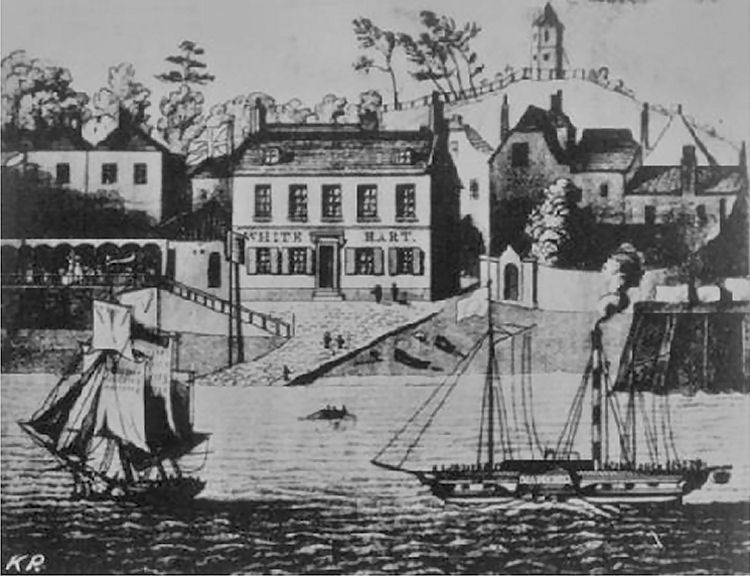
Above painting 1700s. |
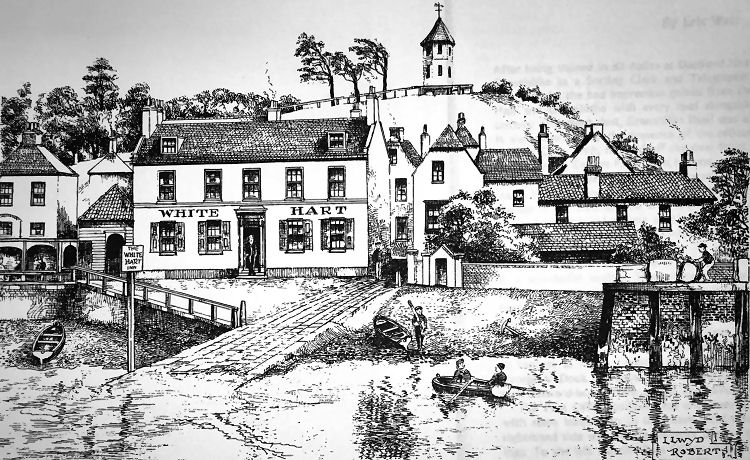
White Hart print, 1830 by Llwyd Roberts. |
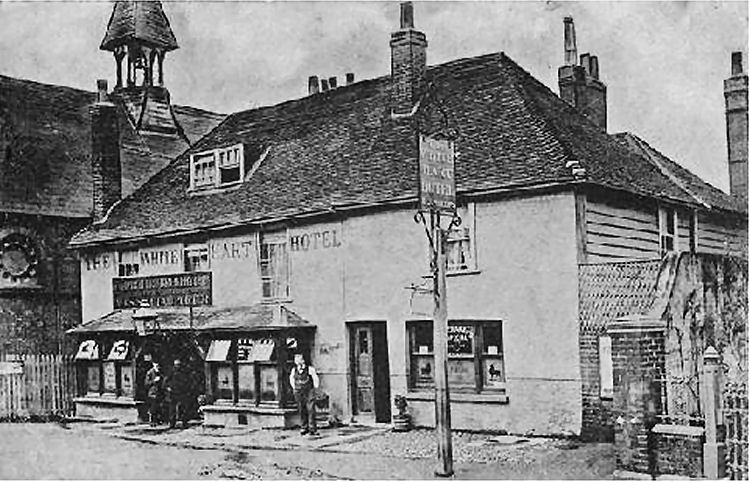
Above photo 1910. |
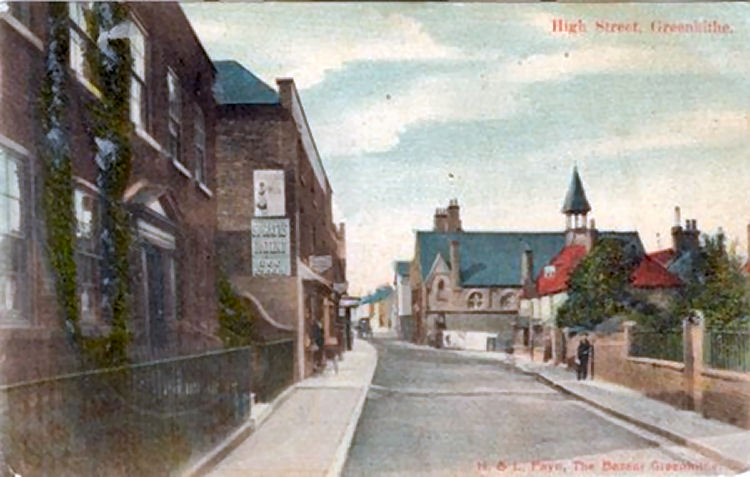
Above postcard, date unknown, showing the "White Hart" with the red
roof, and beyond that the Roman Catholic Church. |

Above photo 1930s. Image Copyright David Milbank Challis. |
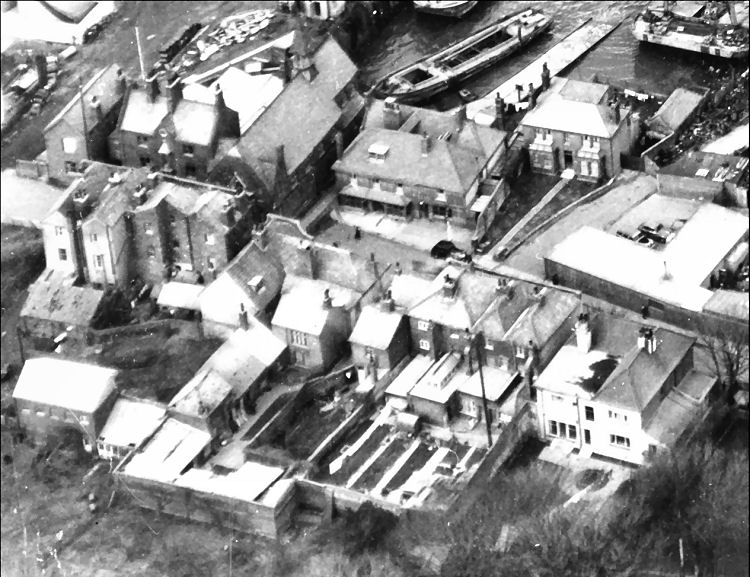
Above photo, 1974. As of 2019 the old barge shown in the photo is
still there. Image Copyright David Milbank Challis. |

Above photo July 1989, kindly sent by Philip Dymott. |
The premises started on back circa 1661 as the "King's Head" but changed
to the "White Hart" between 1742
and 1832. It stayed with this name till 2000 and then became the "Sir
John Franklin."
There used to be a public passageway to the left side of the pub which
ran down to the tidal river foreshore between the public house and the side
of the catholic church. This led to a public causeway and drawdock, that any
vessel could be moored in the dock space.
This public causeway was originally where the public ferry landed on the
Kent side of the river, it crossed the river from Thurrock and was
traditionally the point where pilgrims from Essex and East Anglia crossed on
their way to Canterbury. This unfortunately closed in the late 1970s when a
new seawall brought about the loss of the public causeway known then as the
Everard Drawdock, and access to and from the River by boat is now only
possible for an hour or so either side of the high tide, which occurs twice
daily.
The current (2012) publicans incorrectly suggest the causeway was not
private or exclusive, and they originally wanted to rename the pub
'Allison's Bar' before reluctantly settling on the "Sir
John Franklin."
In 1840, the pub was redesigned and built to face onto the Thames to
service visiting boat crews.
It was reported that on 18th May, 1845 that Sir John Franklin spent the
night at Greenhithe before embarking on what was to later become known as
Franklin's Lost Expedition. The expedition set sail from Greenhithe,
England, on the morning of 19th May 1845, with a crew of 24 officers and 110
men. The ships stopped briefly in Stromness Harbour in the Orkney Islands in
northern Scotland, and from there sailed to Greenland with HMS Rattler and a
transport ship, Barretto Junior.
In 1861, The Royal Thames Yacht Club Fleet was moored on the Thames at
Greenhithe. Established in 1775, The Royal Thames Yacht Club (RTYC) is the
oldest sailing club in the United Kingdom. The Royal Thames Yacht Club held
its sailing races off Greenhithe, with the "White Hart" pub serving as its
clubhouse.
Robert Falcon Scott, CVO (6 June 1868 – c. 29 March 1912) was a Royal
Navy officer and explorer who led two expeditions to the Antarctic regions:
the Discovery Expedition, 1901–04, and the ill-fated Terra Nova Expedition,
1910–13. During this second venture, Scott led a party of five which reached
the South Pole on 17 January 1912, only to find that they had been preceded
by Roald Amundsen's Norwegian expedition. On their return journey, Scott and
his four comrades all perished from a combination of exhaustion, starvation
and extreme cold. On June 1, 1910, the Terra Nova was towed away from the
South-West India Docks as cheering crowds stood by. Scott did not sail with
the Terra Nova as he remained behind in an attempt to raise additional
funding. Scott, with his wife, left the ship at Greenhithe, most likely
coming ashore via the passageway by the "White Hart," where at some point he
was presented two flags by the late Queen Alexandra, (the Queen's Mother)
one flag to be planted at the farthest south attained while the second to be
hoisted at the same spot and then brought back.
Records of that time showed the passageway also provided public access to
the river and foreshore. This is why the flood defence wall which runs
across the public passageway was designed to include a set of concrete steps
in order retain public access to and from the River Thames on foot only.
This is achieved by walking up, over and then down from the flood defence.
This important aspect of the flood defence allows for free pedestrian access
along the entire length of the public right of way from the High Street to
and from the River to continue.
Project 2014 has been started to try and identify all the pubs that are
and have ever been open in Kent. I have just added this pub to that list but
your help is definitely needed regarding it's history.
As the information is found or sent to me, including photographs, it will
be shown here.
Thanks for your co-operation.
|
South Eastern Gazette, Tuesday 29 May 1832.
Frightful Mortality.
On Monday last, the inhabitants of the little village of Greenhithe,
in this County, was thrown into great consternation, in consequence
of several persons being suddenly seized with a virulent complaint,
which terminated their existence in a few hours. As many of the
symptoms of the disorder bore some resemblance to those of the
spasmodic cholera, the medical practitioners in that quarter rather
prematurely declared it to be so; and the cases were, accordingly
reported to the central board of health in London. Upon farther
enquiry it was ascertained that the mortality had been caused by the
individuals, who have come to an untimely end, partaking of
periwinkles and a putrid state, which were brought to the village on
the Saturday previous, and sold to the labouring classes that a very
cheap rate. This shellfish is stated by medical writers to be
extremely unwholesome; and, when putrid, to be poisonous. From
Monday till Saturday, upwards of 70 persons have been attacked; and
of that number we regret to say, but not less than 18 have died. We
are assured, however, by respectable correspondent, that not one
death has happened, except in the instant of those who had partaken
of the periwinkles. In order to set the matter at rest, the rector,
churchwardens, overseers and all the respectable inhabitants of the
village have insisted that an enquiry should take place; and the
coroner's inquest is to be held upon the body of one of the
unfortunate men. The victims include men, women, and children of all
ages; and it is unnecessary to add, that the unhappy occurrence has
cast of deep gloom over the village.
The Cholera at Dartford.
We are sorry to announce the appearance of the Cholera at Dartford.
The official reports from the council office, at Whitehall, of the
26th instance, state the number of new cases to be 9; the deaths, 4;
recoveries 5, and the total deaths 9.
|
|
Chelmsford Chronicle, Friday 1 June 1832.
Motility at Greenhithe.
The official Cholera Returns continue to announce that the disease
exists at Swanscombe and Greenhithe, but some of the London Papers
deny the assertion, and states that the great number of deaths that
have recently occurred at Greenhithe, were occasioned by person's
eating periwinkles in a putrid state.
We have received the following communication upon the subject. The
letter of our Correspondent is dated South Ockendon, the 27th May.
"For fear you should not have been correctly informed with regard to
the number of deaths which have unfortunately taken place at
Greenhithe, opposite the West Thurrock Ferry, the last few days, I
write to inform you that in the period from last Monday afternoon up
to last evening, 19 men, women, and children have died in
consequence of partaking of periwinkles. It appears that the late in
the evening of 18th, a boat of about 5 tons burthen dropped down to
Greenhithe, having about 8 or 10 bushels of that shellfish not
boiled. A man, who retails fish at Greenhithe, went off, and
purchased two bushels, for which he gave for 4s. 6d. (the customary
price being, as I am informed, from 8s. to 10s. per bushel.)
Yesterday week, the 19th, he boiled them and sold a few in the
afternoon of the same day, and the persons who partook of them were
greatly affected, but not so much as to produce a fatal result, and
most of the persons have recovered; of the purchases after that day
many have died, and more are expected not to survive. The first
person who was taken off was the wife of a waterman; she complained
of being extremely ill at 11 on Monday, and was a corpse by 3 in the
afternoon of the same day. A very fine healthy young man was a next
to share the same fate. From the manner in which these person's have
been affected, it was immediately rumoured that they had died of
cholera, and other persons who were taken ill were treated
accordingly, which treatment, I am informed, was not proper under
the circumstances, but too many days had elapsed before the medical
gentlemen were aware that the eating of periwinkles was the cause of
this sad catastrophe. When the truth was known, strong emetics were
resorted to, and had the desired effect, bringing the periwinkles
off the stomach, swollen to a very large size. It was then decided
upon to open some of the bodies of the deceased, when the only
remaining substance of food discovered in the stomach was the
noxious shellfish. Of the real facts of the case, I'm further sorry
to observe, that the extent of this said business is not known. One
person in the village purchased half a peck of the fish to send to
some friends a few miles from Greenhithe, which caused the death of
three persons in one house. There were two men and a boy on board
the periwinkle boats, and it was supposed they have been to London,
selling them as long as they could, when they proceeded downwards.
Not a single person in the village, I believe, was unwell until the
arrival of the fish."
The Maidstone Gazette referring to the melancholy subject, says. "In
order to set a matter of all at rest, the rector, churchwardens,
overseers, and all the respectable inhabitants of the village have
insisted that an enquiry should take place; and the coroner's
inquest is to be held upon the body of one of the unfortunate men.
The victims include men, women, and children of all ages; and it is
unnecessary to add, that the unhappy occurrence has cast a deep gloom
over the village."
From the letter of our correspondent and other circumstances, we are
inclined to consider that it has been brought into action by persons
predisposed to the disease having eating the shellfish in an
unwholesome state. It is a fact well known to medical men, that in
many cases of cholera the latest disposition to the disease has been
brought into sudden and active operation, by the eating heartily of
fish. The Official Returns on Wednesday give three new cases and 3
deaths at Swanscombe and Greenhithe, on the 29th, and it is to be
recollected that the first cases occurred so far back as a 19th, and
it cannot be supposed any persons had for several days past ventured
to partake of that, which is alleged to have caused so much
mischief.
The Maidstone Gazette states, that the Cholera is at Dartford, and
the official returns announced that it broke out at Bexley, a short
distance from Dartford, on the 23rd.
|
|
From the South Eastern Gazette, Tuesday 5 June 1832.
Mortality at Greenhithe.
On Tuesday last, and inquest was held at the "White Hart,"
Greenhithe, on the bodies of William Scott West, and James
Westbrook, who were supposed to have died in consequence of eating
putrid periwinkles. The great mortality, which has taking place in
this village, the particulars of which appeared in our last
publication rendered this public enquiry essentially necessary,
which was attended by some of the most respectable inhabitants of
Greenhithe and the vicinity. Among persons present were, the Rev.
Archdeacon King, Rev. Mr. Deacon, Rev. Mr. Otter, Capt. Hill, R. N.
Rev. G. C Renouard &c. The Jury having been sworn in, Mr. Wilson,
surgeon, in Greenhithe, was examined at considerable length. This
gentleman stated that he had analysed the contents of the stomachs
of the deceased, and of other persons who had suddenly expired, the
result of which had led him to the conviction that they deaths have
been caused by eating putrid periwinkles. The witness entered into
some medical details in order to show that this shellfish, when in a
putrid states, would destroy life. He also stated that no one had
died but those who, it could be proved, have partaken of these
periwinkles. A verdict to that effect was instantly returned.
Immediately after the verdict was announced, several individuals,
who had quitted the village, returned to it, and we are happy to
say, that the alarm has has now completely subsided. The number of
deaths has been 28, and about 70 persons have been attacked.
|
|
Canterbury Weekly, 12 November, 1836.
Dartford Petty Sessions.
(Before G. C. Reynolds, Esq., and a Bench of Magistrates.)
Mr. George Young, the master and part owner of the Tritton brig, who
was brought before the magistrates on Monday last, for final
examination on the capital charge of wounding William Granger, the
captain of the Nimble sloop, and Robert Sprout, the mate of his owe
vessel.
The wounded men had been removed to the "White Hart Inn," Greenhithe,
at which place the lamentable affair occurred, and they still
remained in such a dangerous condition that it was deemed advisable
for one of the resident magistrate's to proceed to Greenhithe to
take their depositions. Mr. Renouard accompanied by Mr. Hayward, the
clerk of the bench, accordingly went to Greenhithe, and saw both of
wounded men, and their depositions were then taken. They were to the
following effect:-
William Grange deposed that he was captain and owner of the sloop
Nimble. On the 31st of October the vessel was lying off the wharf, at
Greenhithe, taken in a cargo of ballast. The Triton brig was
alongside, and some other people had fastened a pope from her to the
windlass of the Nimble without leave, and the strain so caused upon
her broke her mooring rope. Witness told his mate, Fenton, to cast
off the rope, which he did. The captain of the Triton came up and
abused him very much for casting off the rope, and a minute or two
afterwards Robert Sprout, then mate of the Triton, came on board the
Nimble, and insisted upon fastening another rope to her; but witness
refuse to allow him, and he then put himself into a fighting
attitude. Witness asked them what they meant by such conduct, and
told them they had broke his vessel adrift already. The second rope
was fastened, however, to the vessel in spite of their
representation; and witness then went and cut the rope. The night of
the Nimble held the man belonging to the other vessel, while witness
was cutting the rope. Witness, at this moment, saw the prisoner
standing on his own quarterdeck with a gun in his hand, which he
levelled deliberately at them, and then pull the trigger, but the
gun missed fire. He pulled it a second time, and it went off and
wounded witness and Sprout, the mate, and they both fell on the deck
together. The prisoner was not more than 12 or 13 feet from them
when he fired.
Roberts Sprout deposed that he was the mate of the Triton. On the
day in question he was going to haul the brig off, and the master of
the Triton, the prisoner, told him to make a line fast to the sloop
that was alongside, which he did; and they towed the brig astern.
Their brig hauled the sloop away from the wharf, and the people that
were on board her cast off the line. Witness jumped on board the
sloop, and made another line fast, and, while he was so doing, a man
struck him. The line was then cut in two places. A scuffle then took
place during which time he heard a shot fired, and he fell wounded.
He did not know who fired the shot.
Robert Fenton, then mate of the Nimble, deposed that they dropped
down from Limehouse to Greenhithe on the 31st of October, for the
purpose of taking in the ballast at the chalk wharf. While they are
engaged in taking in the ballast, the mate of the Triton came on
board the Nimble and fastened a line to the windlass bits. The
strain from the brig broke the sloop's headrope, and towed her away
from the wharf, and they got adrift. Witness then cast off he rope,
and they got another headrope ashore, and were houled in again to
the wharf. Another man then came from the Triton, and fastened a
rope to their main-sheet cleat, and witness was about to cast it
off, when he was struck by the mate Sprout.
A scuffle took place, and the captain, Granger, came up, and
parted
them. At this moment he war Captain Young standing on the
quarterdeck of the Triton with a gun in his hand. He presented the
gun towards them all, and the second time he pulled the trigger it
went off, and Sprout, the mate, and Captain Granger, fell on the
deck, wounded. Captain Grainger explained, as he was falling, "I am
a murdered man." Before the gun was fired, witness called out too
Young, "Avast there, what are you going to do," but he took no
Notice.
Samuel patients, a labourer, employed at the chalk wharf,
corroborated the evidence given by the preceding Witnesses.
The prisoner, who declined saying anything in answer to the charge,
was then committed to Maidstone gaol for trial.
|
|
From a local paper April 1853.
White Hart Gaslight Meeting.
On Wednesday evening last a public meeting was held at the "White
Hart Inn," James Harmer, Esq., (formerly an alderman of the city of
London) in the Chair, for the purpose of considering the propriety
of lighting the hamlet of Greenhithe and the village of Swanscombe with gas.
The great room was crowded with the chief gentry and
principal inhabitants of the neighbourhood, amongst whom we noticed
Messrs. Tannings, Fox, Vogan, Goodeve, Seccombe, West, and A.
Hassell. The meeting was addressed by Alfred Russell, Esq., of
Dartford, J. B. White, Samuel White, and John Smith, Esqrs., and
Messrs. Cobham and Roberts.
It appeared from the speech of A.
Russell, Esq., that the costs of the works would amount, including
the purchase of the land, to about £2000, and that shares had
already been offered to be taken to the amount of £2500. A question
elicited the reply that about forty lights would be required to
illuminate the darkness in which the inhabitants had “so long lain
hid.” Mr. Mead, of the firm of Squire an Co., gas engineers, of the
Borough, also attended, prepared to reply to such queries as should
be put to him.
The meeting unanimously resolved that it was
desirable to light the hamlet of Greenhithe with gas. And Mr. White
stated that in Australia he had seen smaller places than Greenhithe,
with less population, spring up into large towns almost as soon as a
gasometer had been erected; and he had no doubt that their hamlet
would soon become of more importance than hitherto. In this we
agree, for it possesses every capability for improvement – a nice
neighbourhood and great facility for travelling too and fro to the
metropolis – a pier for the steam boats, and a station for the North
Kent Railway.
The country around is most delightful and healthy. A
question was put as to the cost of gas to the consumer, and it was
answered 7s. per 1000 at first, and that as its use became extended
and more gas was consumed, so the price would fall to 5s.
It was
stated that the Northfleet company has made an offer to introduce
gas, at once at 5s., but this offer was almost unhesitatingly
declined, as the meeting considered that they should be better
served by having works of their own; a resolution was consequently
unanimously passed, that with a view to the attainment of the above
most desirable object, and for the purpose of carrying the same into
effect, James Harmer, J. B. White, sen., Fox, West, R. White, and
Goodeve, Esqrs., be appointed a committee of management.
After a
vote of thanks to Mr. Harmer, for his conduct in the chair, the
meeting broke up. The next step will be, some ten days hence, to
obtain the consent of a parish vestry, under the Act of Parliament.
|
|
From a local paper 1966.
A ghost road in Greenhithe.
Greenhithe High Street, once the heart of a busy and beautiful
little village is rapidly turning into a ghost road. Shutters board
the windows of the fish and chip shop and the café, and rubble marks
where old cottages have been demolished.
Many of the old villagers
have been moved out to states in Swanscombe, and no newcomers have
come to take their place.
What is Greenhithe like to live in?
“It’s
a dying community”, said Mr. Pat Fletcher, for 27 years landlord of
the White Hart public house.
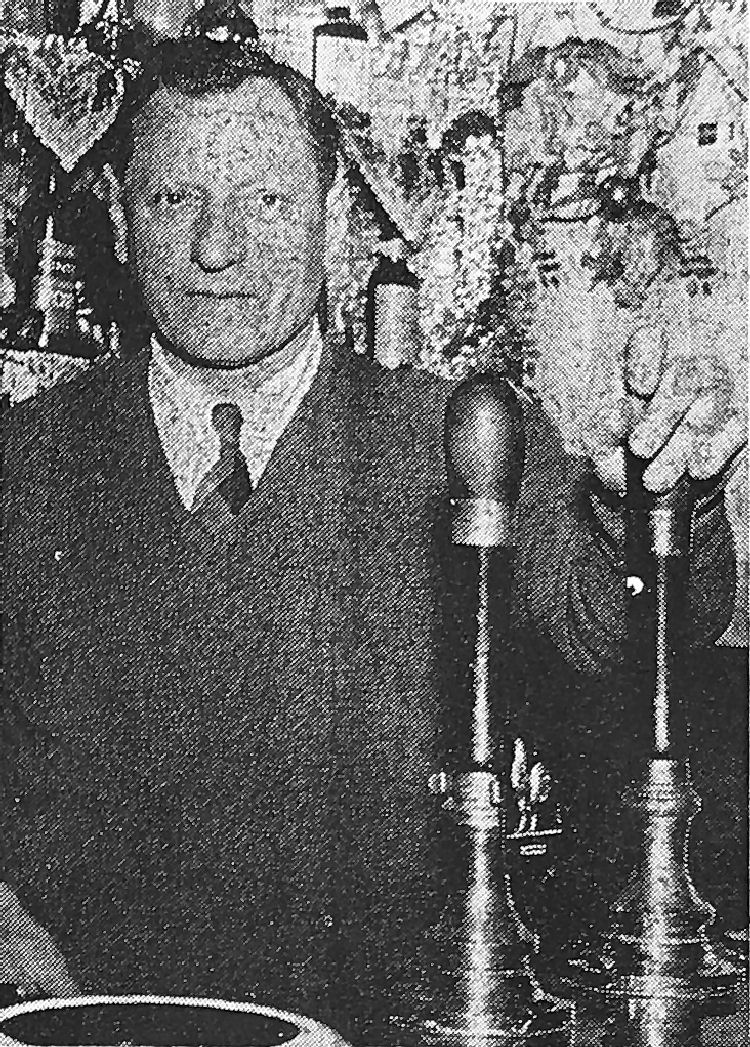
“When I first came here, we were often
quite busy, and had a good local trade”, he said “Of course there
were 50 more houses in the High Street then”. “Nowadays we have
virtually no regular trade, and when there are no boats in the
shipping yard business is really slack”. “The only busy day we’ve
had recently was when the Queen visited H.M.S Worcester – nearly
four years ago”.
Mr Fletcher’s view was confirmed by another old Greenhithe resident, Miss Doris Challis, who together with her three
brothers has run a bakery for 50 years.
“There is no village spirit
these days”, she said, “At one time there were whist drives every
week, and the dances at the Village Hall were always packed”.
Challis is now the sole survivor of three bakers in the High Street.
Miss Challis remembers when Greenhithe lived up to its name. “There
was grass down to the river, and behind the White Hart was a
yachting centre”, she recalled.
Greenhithe forms part of Swanscombe
Urban District but residents in the High Street still like to think
of it as a separate village.
“There definitely was a village
atmosphere at one time”, said Mrs. D Carr who like her sister, Mrs E Presland was born in the village and has lived there all her life.
“There was a school in the Roman Catholic Church and it was a very
pretty village”, she said.
Another lady who still thinks of Greenhithe as a separate village is Mrs. M Moss, who has run her
newsagent’s business for 31 years.
“I certainly don’t consider Greenhithe as being part of Swanscombe”, she said, “but on the other
hand there is no village community spirit left”.
There is a rumour
in the village that a block of flats will be erected at the east end
of the High Street on the site of an old house called The Eagles.
A Swanscombe Council spokesman confirmed that this was “a faint
possibility”, but that the matter has not yet been put before the
council. If the flats materialise then perhaps Greenhithe will be
able to look forward to renewed life. Until then the High Street
sleeps on.

|
|
From the Dartford Times, 7th Feb 1991.
Front Door at the Back.
Stories of ghost and spooks surround the borough’s only true
Thames-side pub. Historians believe the "White Hart" in High Street, Greenhithe, dates back to 1799 and may have once been called The
"King’s Head."
In 1840 it was also a ferry house with its own causeway
into the river. The terrace, raised several feet above tidal
defences, backs directly onto the river. Present owner Terrance
Harris is not convinced about the legend. He said: “I have often
heard people talking about ghosts in the pub but I have never seen
any.” “People who have lived in the area for years say an old seaman
who was a ship’s captain stalks the building.”
In 1845 Sir John
Franklin stayed the night at the "White Hart" before launching an
ill-fated expedition in search of the North West Passage. Old
photographs reveal that what is now the back of the pub used to be
its entrance.
Mr Harris, who has run the pub for eight years, added:
“The entrance has been changed. Visitors used to come in from the
back before a wall was built. We have got some very old photographs
showing people coming in with the river behind them.”
Late Victorian
landlords, the Blois family, went on in 1904 to the "Fulwich Hotel,"
which they ran for many years. Displays of nautical knots in the
panelled saloon reflect the sea faring connections. The pub is
featured in Cheers! A Hundred Years, A Hundred Pubs.
|
|
'White Hart Entry from Unknown book'.
The rear terrace here, raised several feet on top of tidal defenced,
backs onto the river, making the "White Hart" the Borough’s only true Thameside pub. There was certainly a
"White Hart" here by 1799, and it
may previously have been called the "King’s Head."
Around 1840 it
was also a ferry house, with its own causeway into the river.
Today’s half-timbered cladding is just one of a series of disguises
– in the mid-1800s it sported fashionable stuccoed walls.
In those
days the door now leading to the rear yard was the main entrance,
facing the quayside. Late-Victorian landlords the Blois family went
on in 1904 to the "Fulwich Hotel," which they ran for many years.
Displays of nautical knots in the panelled saloon reflect sea-faring
connections. It was here, in 1845, that Sir John Franklin stayed the
night before launching his ill-fated expedition in search of the
North West Passage.
|
|
From an email received 19 January 2024. Hello, I have a question.
I found this walking stick and I would be interested to know if they
know if there were several such objects in the past.
I would be happy to find out more about it, because this
beautiful pub still exists, which is very beautiful. Was that a
souvenir?
Greetings from Freiburg Germany.
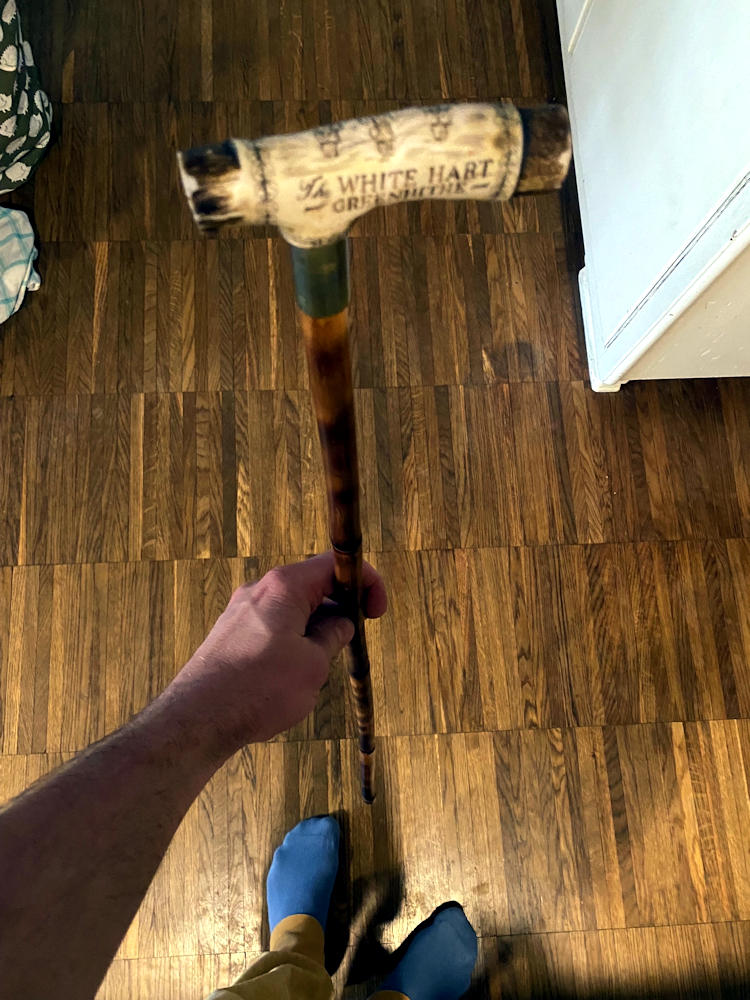
Above photo showing the walking stick.
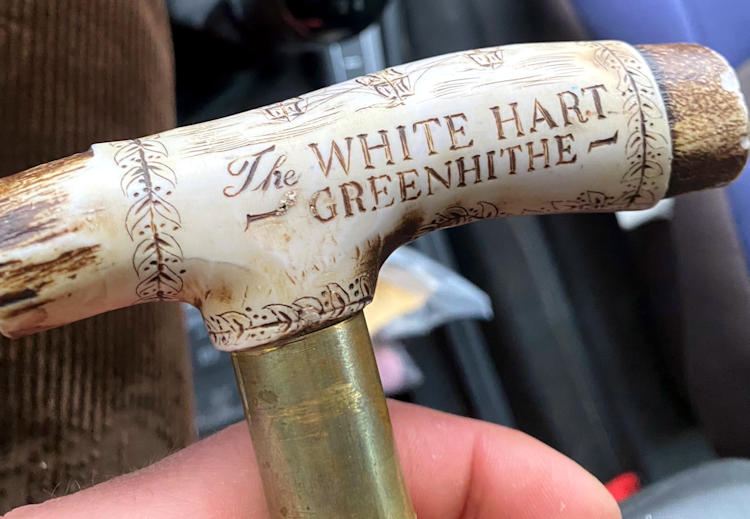
Front of stick handle.
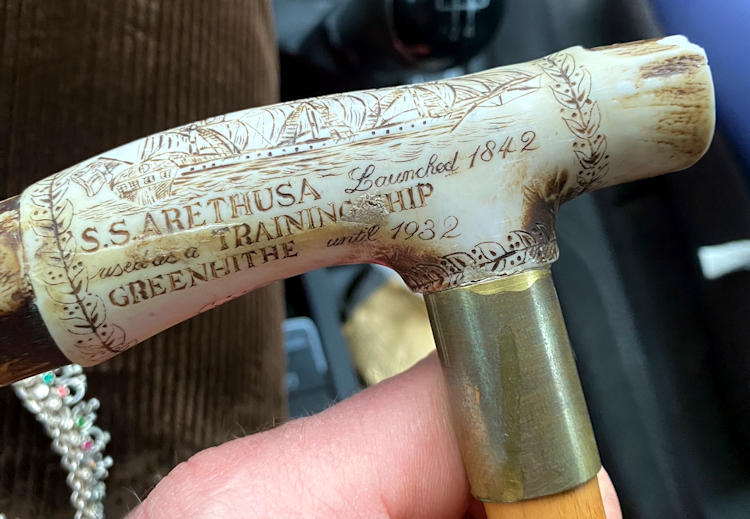
Rear of stick handle.
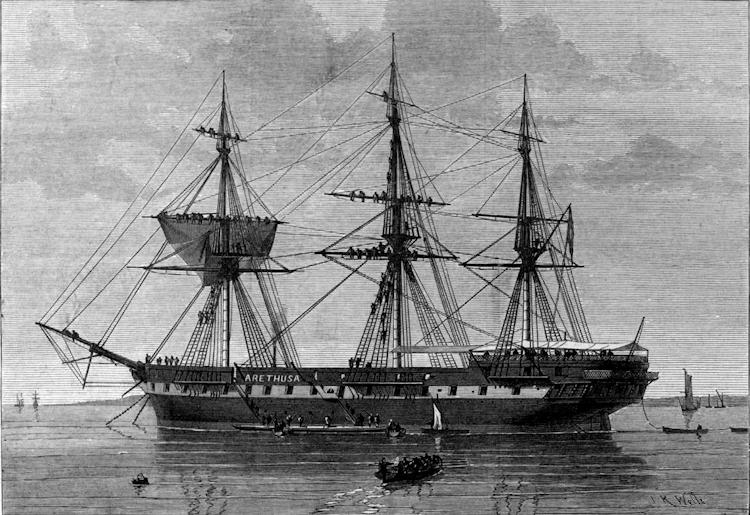
Print of training ship for boys, "Arethusa" in 1875.
|
LICENSEE LIST
VITOU Peter 1832-58+ (age 65 in 1851 ) )

VITOU Miss S 1862+
VITOU Mrs Sarah 1874+
VITOU Emma 1881+ (age 62 in 1881)
VITOU Mrs Sarah 1882+
REYNOLDS William John 1891+ (age 28 in 1891)
BLOIS William Ambrose 1901-03+
 (age 59 in 1901) (age 59 in 1901)

PHILLIPS Benjamin J 1913-22+
FLETCHET Pat 1939-66+
HARRIS Terrance 1983-91+
https://pubwiki.co.uk/WhiteHart.shtml
 From the Pigot's Directory 1832-33-34 From the Pigot's Directory 1832-33-34
 From the Kelly's Directory 1903 From the Kelly's Directory 1903
|












